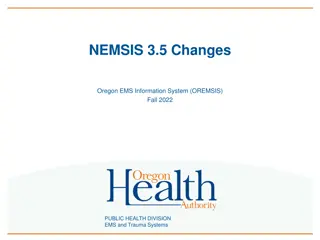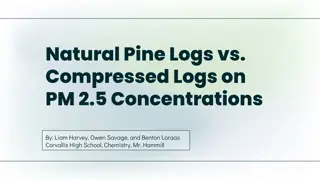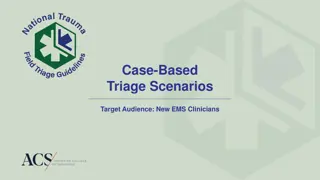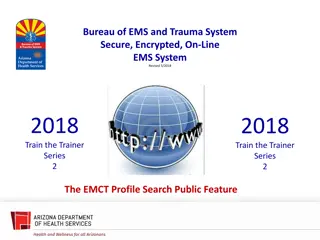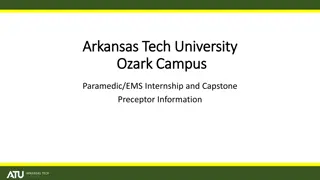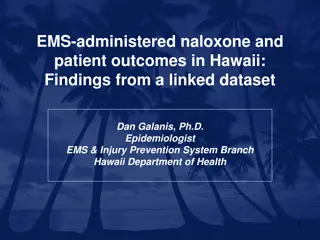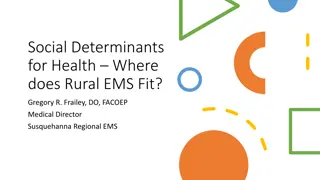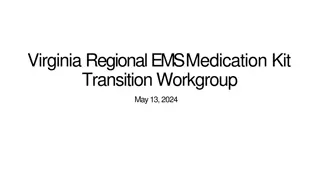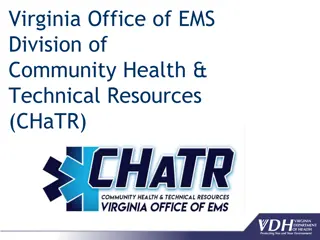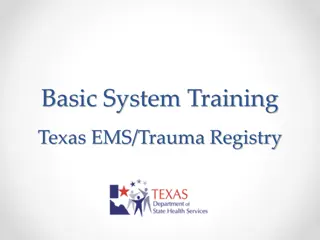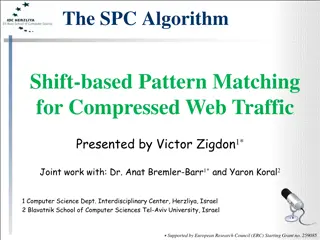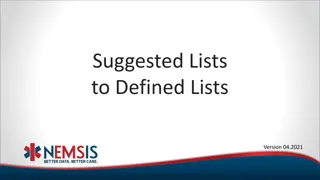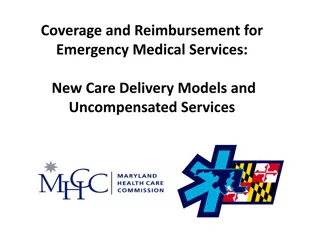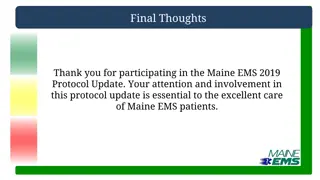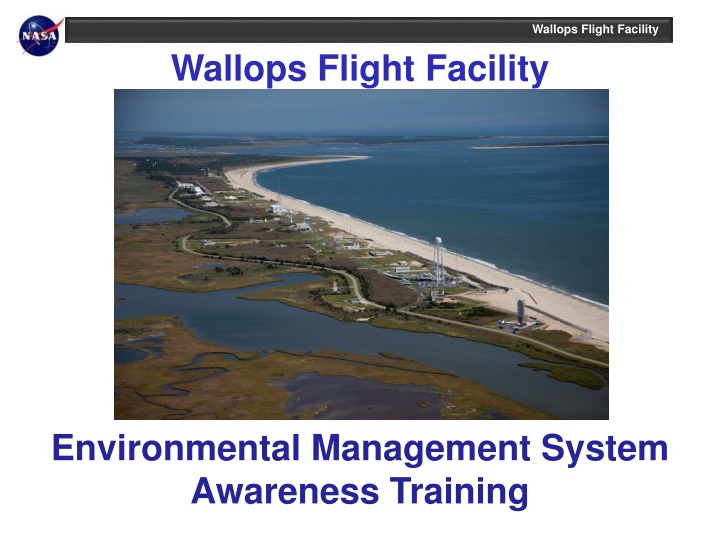
Wallops Flight Facility Environmental Management System Training Overview
"Explore the key elements of Wallops Flight Facility's Environmental Management System (EMS) training, focusing on sustainability, environmental policy, mission priorities, and the importance of an EMS for NASA's operations. Learn how EMS integrates into day-to-day job functions and supports sustainable practices for a better future."
Download Presentation

Please find below an Image/Link to download the presentation.
The content on the website is provided AS IS for your information and personal use only. It may not be sold, licensed, or shared on other websites without obtaining consent from the author. If you encounter any issues during the download, it is possible that the publisher has removed the file from their server.
You are allowed to download the files provided on this website for personal or commercial use, subject to the condition that they are used lawfully. All files are the property of their respective owners.
The content on the website is provided AS IS for your information and personal use only. It may not be sold, licensed, or shared on other websites without obtaining consent from the author.
E N D
Presentation Transcript
Wallops Flight Facility Wallops Flight Facility Environmental Management System Awareness Training
Wallops Flight Facility Training Overview Wallops Flight Facility (WFF) Environmental Management System (EMS) Key Elements: EMS Introduction Sustainability Environmental Policy Mission and The Environment High Priorities Emergency Preparedness and Response Spill/Release Prevention Highlights To Remember Quiz 2
Wallops Flight Facility Why Have an Environmental Management System (EMS)? NASA is required to implement an EMS to: Promote effective environmental management. Meet Federal sustainability goals and objectives. An EMS reduces NASA s risk by: Identifying significant environmental impacts of programs and projects. Minimizing mission delays and costs due to failure to address these impacts. 3
Wallops Flight Facility Sustainability is Interwoven in WFF s EMS Sustainability means: Executing NASA s mission without compromising our planet s resources. Providing future generations with an environment that is protected and enhanced. Investing smart to save valuable resources, which can then be used to support the mission. Managing risks to mission, the environment, and our communities. EMS provides the framework for executing sustainable practices in our day-to-day job. 4
Wallops Flight Facility EMS Policy - How Is EMS Integrated Into Your Day-to-Day Job? The Goddard Space Flight Center (GSFC) missions expand knowledge of the Earth and its environment, the solar system, and the universe. To maintain our nation's leadership in this endeavor, GSFC commits to conducting missions in a manner that promotes environmental stewardship. As an integral part of all mission planning and implementation, environmental policy is to: GSFC s Comply with all applicable Federal, state, and local laws and regulations, Executive Orders, NASA policies, and other requirements; 5 Goddard Procedural Document 8500.1 Environmental Policy and Program Management
Wallops Flight Facility EMS Policy - How Is EMS Integrated Into Your Day-to-Day Job? Prevent pollution, conserve natural resources, and consider the environmental impacts of Center actions during planning; Implement pragmatic and cost effective solutions to environmental challenges; and Communicate with GSFC s community, our partners, and the public. 6
Wallops Flight Facility EMS Policy - How Is EMS Integrated Into Your Day-to-Day Job? Continue to improve our environmental performance by: Promoting awareness through education and training; Integrating environmentally sustainable best management practices into our daily work activities; Exploring advances in environmental technology; and Providing a framework for setting goals, objectives and targets through our Environmental Management System (EMS). 7
Wallops Flight Facility EMS Policy - How Is EMS Integrated Into Your Day-to-Day Job? These commitments demonstrate GSFC s environmental stewardship in our community. 8
Wallops Flight Facility Mission and Environment Example 1 WFF s activities interact with the environment. Every activity has an environmental impact, whether good or bad. Causes WFF Activity Effect Air quality, quality of life issues. Noise, increased air pollutants. Aircraft Touch n Go Operations. An A-10 aircraft landing at WFF s runway during a training exercise. Here is a brief landing is followed by an immediate take-off (Touch n Go). 9
Wallops Flight Facility Mission and Environment Example 2 Causes Effect WFF Activity New construction or rehabilitation of existing facilities. Increased sedimentation in surface waters and habitat degradation. Water quality issues, including storm water and wetland impacts. Silt fence installed at construction sites prevents storm water debris from entering local waterways and impacting surface water. 10
Wallops Flight Facility Mission and Environment Example 3 Effect WFF Activity Causes Noise, increased air pollutants, and animal disturbance. Air quality issues, protected species impacts. Rocket launches. Orbital rocket launch from Wallops Launch Pad 0-A. 11
Wallops Flight Facility As a result of our dynamic mission, management annually focuses on the top environmental issues, which are identified by a team of employee representatives. High Priorities may include: Water Quality Protected Areas and Protected Species Sustainability Environmental Planning Site Restoration Hazardous Waste Air Emissions Check the Code 250 website to view the current High Priorities: https://code200-external.gsfc.nasa.gov/sites/code250- wffe/files/documents/WFF_Environmental_Priorities.pdf 12
Wallops Flight Facility Water Quality Why This Is Important? The Eastern Shore has limited water resources. Our activities may generate impacts to surface water. Good water quality is the focus of WFF s water program. Environmental testing ensures high quality drinking water. 13
Wallops Flight Facility Water Quality What Can You Do? Help WFF reduce potable water use intensity. Use the smallest amount of water that achieves the objective. Don t run water faucets unnecessarily. Promptly report water leaks. Reduce use of toxic and hazardous chemicals. Prevent pollution and recycle. Maintain equipment properly to avoid drips and spills. Review the Drinking Water Quality Report at https://code200-external.gsfc.nasa.gov/250-wff/documents#cat2 14
Wallops Flight Facility Protected Areas and Protected Species Why This Is Important? Environmentally sensitive areas exist at WFF (wetlands and dunes). Threatened and endangered species make WFF their home. Marine mammals and reptiles are often stranded on Wallops Island. Loggerhead sea turtle hatchling entering the surf at Wallops Island. Wetlands on Wallops Island. 15
Wallops Flight Facility Protected Areas and Protected Species What Can You Do? Consider environmentally sensitive areas in mission planning. Avoid posted Piping Plover nesting areas on recreational beach during the April to October nesting season. If you see a stranded marine mammal or sea turtle, call the HELP desk (x4357) or 757-824-2466 by cell phone. American Oystercatcher at Wallops Island. 4 newly hatched piping plover chicks on Wallops beach. 16
Wallops Flight Facility Energy Management/Sustainability Why This Is Important? Reducing energy use saves money and reduces green house gas emissions. Using environmentally preferable products and sustainable practices reduces toxins in the environment, makes more efficient use of resources, and saves energy. Liquid propane tanks replaced fuel oil tanks on the WFF Main Base. 17
Wallops Flight Facility Energy Management/Sustainability What Can You Do? Turn off lights and equipment when not in use. Place recycleables in single stream recycling containers. Purchase Energy-Star, recycled content, environmentally preferable, and biopreferred products. Learn more about these programs at: https://code200-external.gsfc.nasa.gov/250- wff/program-areas-green-purchasing Contact the WFF Environmental Office at (757) 824-2127 for assistance. 18
Wallops Flight Facility Environmental Planning Why Is This Important? New missions require early environmental analysis to: Avoid mission delays. Enable environmentally sound mission success. Comply with federal law. Orbital rocket launch Shoreline Restoration and Infrastructure Protection Program Horizontal Integration Facility What Can You Do? Contact the WFF Environmental Office early in the planning of your project. 19
Wallops Flight Facility Site Restoration Why This Is Important? Remediation of historic contaminated sites protects human health, the environment, and returns the land for mission use. Institutional controls are in place to educate our work force and protect our natural resources. What Can You Do? Check the environmental layers on the Geographic Information System (GIS) database before scoping a project location. Call the Environmental Office for support. D-37 Aviation Fuel Tank Farm tanks removed to prevent groundwater contamination. 20
Wallops Flight Facility Air Quality Why This Is Important? Reduce air emissions, their impacts, and maintain compliance with existing permits and regulations. Reduce Greenhouse Gas emissions and monitor use of Ozone Depleting Substances. What Can You Do? Consider alternative methods, fuels, or equipment to further reduce pollution and emissions. Report new emission sources to the Environmental Office paint booths, fume hoods, fuel burning equipment, etc. 21
Wallops Flight Facility Hazardous Waste Why This Is Important? Proper hazardous waste managemnt protects human health and the environment. What Can You Do? Attend WFF Resource Conservation and Recovery Act (RCRA) Generator Training and Integrated Contingency Plan Training annually. Contact the Environmental Office at (757) 824-1718 before generating a new hazardous waste or whenever you have questions. Keep containers closed and properly labeled. Properly labeled hazardous waste container. 22
Wallops Flight Facility What If You Encounter an Environmental Emergency? Call 911 or 757-824-1333 (if using a mobile phone) for all spills and releases, and the WFF Fire Department will respond. 23
Wallops Flight Facility How To Prevent Environmental Spills and Releases Follow work instructions when handling fuel or chemicals that may be dangerous to humans or harmful to the environment. Follow equipment preventive maintenance schedule. 24
Wallops Flight Facility How To Prevent Environmental Spills and Releases Attend WFF annual Resource Conservation and Recovery Act (RCRA) Generator Training if you generate hazardous waste. Attend WFF annual Integrated Contingency Plan (ICP) and Storm Water Pollution Prevention Plan Training (SWP3). 25
Wallops Flight Facility Highlights to Remember Be familiar with WFF s Environmental Policy. Consider the environment in your work. Consider smart sustainable practices to support the mission. Be familiar with WFF s High Priorities. Take appropriate training. Know WFF s emergency numbers. 26
Wallops Flight Facility Take The Quiz

